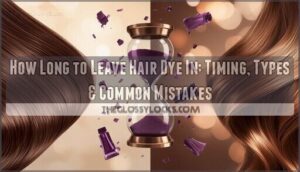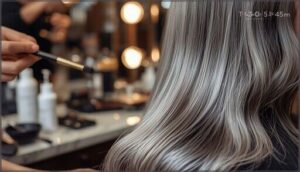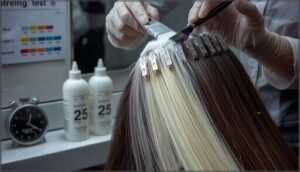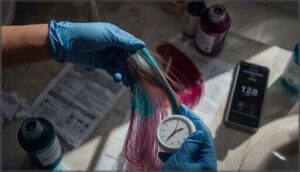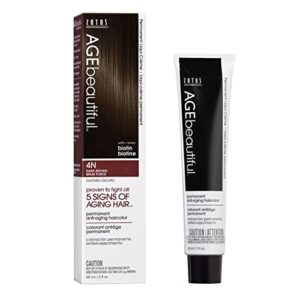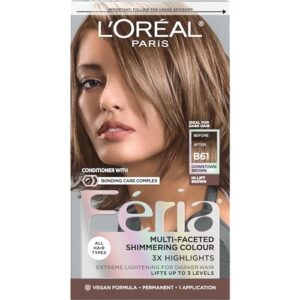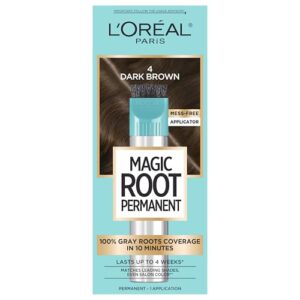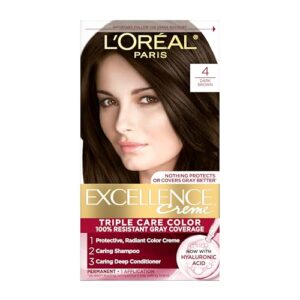This site is supported by our readers. We may earn a commission, at no cost to you, if you purchase through links.
The difference between a hair color disaster and your dream shade often comes down to minutes. Leave dye on too long, and you risk fried, brittle strands. Rinse too early, and you’re left with patchy, faded color that washes out after a few shampoos.
Yet most people treat timing like guesswork, following package instructions without accounting for their hair’s unique characteristics. Your hair’s porosity, texture, and starting color all change how quickly dye molecules penetrate the cuticle and deposit pigment.
Understanding these factors transforms hair coloring from a gamble into a predictable process, giving you control over your results and protecting your hair from unnecessary damage.
Table Of Contents
- Key Takeaways
- Factors That Affect Hair Dye Timing
- Hair Dye Types and Recommended Processing Times
- How to Determine The Right Dye Duration
- Common Mistakes When Timing Hair Dye
- Risks of Overprocessing and Underprocessing
- Aftercare Tips for Dyed Hair
- Top 5 Hair Dye Products for At-Home Use
- Frequently Asked Questions (FAQs)
- Conclusion
Key Takeaways
- Your hair’s porosity, texture, and starting color determine how quickly dye molecules penetrate the cuticle—fine or high-porosity hair absorbs color in 10-20 minutes, while coarse or low-porosity strands need 30-45 minutes to prevent patchy, uneven results.
- Leaving dye on too long causes scalp burns, allergic reactions, and up to 45% loss of hair strength, while rinsing too early leaves you with 15-25% less pigment that fades within 1-3 shampoos.
- Different dye types require specific processing windows—permanent dyes need 30-45 minutes for gray coverage, semi-permanent formulas work in 15-30 minutes, and bleach shouldn’t exceed 20-45 minutes depending on developer strength and your starting shade.
- Aftercare practices like using sulfate-free shampoos, deep conditioning weekly, washing only 2-3 times per week, and trimming every 6-8 weeks can extend your color vibrancy by preventing fade and protecting damaged cuticles.
Factors That Affect Hair Dye Timing
Leaving hair dye on for the right amount of time isn’t a one-size-fits-all situation. Your hair’s unique characteristics and the color you’re aiming for will determine how long the dye needs to work its magic.
Here are the key factors that affect processing time.
Hair Type and Texture
Your hair’s type and texture act like a blueprint for dye timing. Fine hair absorbs color faster—often 20-30% quicker than coarse strands—because its smaller diameter lets chemicals penetrate rapidly. Meanwhile, thick or coarse textures need extra minutes for full saturation. Knowing your hair’s condition is important, as damaged hair absorbs dye differently.
- Fine hair processes optimally in 20-30 minutes
- Coarse hair demands 30-45 minutes minimum
- Straight hair develops evenly within standard timeframes
- Curly hair benefits from 5-10 additional minutes
Hair Porosity
Beyond texture, porosity—your hair’s ability to absorb and hold moisture—controls processing time more than almost anything else. High-porosity strands, often damaged by bleach or chemical treatments, soak up dye in as little as 10-15 minutes, while low-porosity hair with tightly sealed cuticles can take 25-30 minutes to reach the same intensity.
Hair porosity controls dye timing more than texture—high-porosity strands absorb color in 10-15 minutes, while low-porosity hair needs 25-30 minutes
That’s why chemically treated or Afro-textured hair generally requires shorter dye windows, and Asian hair—naturally less porous—often needs the full recommended timeframe. Understanding how your hair absorbs and retains moisture is key, so learning about different hair porosities can greatly improve your hair care routine.
Desired Color and Shade
The color intensity you’re aiming for directly impacts timing. Light shades like pale blonde process in 30 minutes, while dark shades demand 40-45 minutes for full deposit. Vibrant shades—especially reds—can extend to 120 minutes for maximum saturation, and ashy tones often develop within 30 minutes.
Consider these timing benchmarks for achieving desired hair color:
- Pastels need 15-20 minutes for delicate results
- Ruby reds intensify beautifully at 30 minutes
- Deep browns saturate fully around 40 minutes
- Neutral ashy finishes develop in 30-60 minutes
Your hair shade goal determines your clock.
Starting Hair Color
Your starting shade fundamentally reshapes timing. Light blonde bases reach desired tones in 25-35 minutes, while medium brown often requires the full 30-45 minutes for visible change. Dark brown and gray hair demand 40-45 minutes because resistant pigment slows dye penetration.
Previously colored strands process faster—sometimes 5-10 minutes quicker—since their cuticles are already opened from chemical treatments.
Developer Strength and Environmental Conditions
When you select a developer, volume matters. 10-volume processes in 20-30 minutes with minimal lift, while 40-volume can lighten several levels in 45 minutes but risks scalp irritation.
Environmental heat accelerates the chemical reaction: room temperature calibrates most timing guides, but humid climates or warm salons shorten processing windows.
Light exposure and improper storage degrade peroxide activity, throwing off your expected results even within standard time frames.
Hair Dye Types and Recommended Processing Times
Not all hair dyes work the same way. Each type uses different chemical formulations that need specific amounts of time to develop properly.
Here’s what you need to know about processing times for the most common dye categories.
Permanent Hair Dye (30–45 Minutes)
Permanent hair dye is the marathon runner of color treatments—it’s in for the long haul. You’ll usually leave it on for 30 to 45 minutes, depending on a few key factors affecting dye time:
- Gray coverage needs: Resistant gray requires the full 45 minutes for complete color development
- Root application technique: Apply to roots first for 35 minutes, then pull through ends
- Developer volume choice: Higher volumes speed processing but increase over-processing signs like dryness
Demi-Permanent Hair Dye (20–30 Minutes)
When you’re aiming for gentler color shifts without full commitment, demi-permanent hair dye gives you flexibility. Gray coverage reaches about 70% at the 20-minute mark, while fade resistance extends through 16 to 28 washes.
You’ll usually leave it on for 20 to 30 minutes, with this processing time balancing color saturation and scalp sensitivity. Mixing ratios with developer affect your hair dye application time—porous hair needs shorter exposure to prevent oversaturation.
Semi-Permanent Hair Dye (15–30 Minutes)
Semi-permanent hair dye works like a temporary paint—color molecules coat your strands without penetrating the cortex. You’ll process it for 15 to 30 minutes depending on your hair’s porosity and texture.
Here’s what affects your application time:
- High porosity hair absorbs color in 15 minutes, while dense textures need the full 30
- Lighter starting shades show vibrant results lasting 4 to 6 weeks
- Pre-bleached hair extends fade resistance up to 24 washes
- Gray coverage requires 30 minutes under heat for even deposit
- Oily hair types accelerate color breakdown, shortening longevity
Fine hair processes faster than thick strands to prevent oversaturation.
Bleach and High-Lift Color Timing
Bleach requires precision because processing monitoring prevents damage. You’ll leave bleach on hair for 15 to 45 minutes depending on developer strength and starting shade—blonde hair lightens in 15–20 minutes, while dark hair needs about 30.
Bleach developer volume determines intensity: 20-volume processes for 20–40 minutes, but 40-volume shouldn’t exceed 20 minutes. Extended bleach effects include brittleness and breakage.
Controlled lifting means checking every 10 minutes—bleaching hair safely stops once you reach pale yellow.
Natural Plant-Based Dyes (e.g., Henna)
Henna and indigo turn hair coloring into a patient ritual. Pure henna needs 2 to 3 hours on your hair for noticeable color, though gray coverage works best at 4 to 6 hours. Indigo application times range from 30 minutes for brown to 2 hours for black.
These natural dyes won’t damage like bleach, but henna overprocessing causes dryness—stick to every 4 weeks for safe henna usage.
How to Determine The Right Dye Duration
Getting the timing right isn’t about guesswork—it’s about reading the instructions and understanding your hair’s unique needs. Every dye box comes with guidelines designed to work for most people, but your hair’s history and current condition might mean you need to adjust those recommendations.
Let’s break down how to figure out the perfect processing time for your specific situation.
Following Manufacturer Instructions
Your best guide to perfect timing is sitting right inside the box. Manufacturers test their formulas in labs to balance color deposit and safety, then print exact processing times on every leaflet.
Don’t skip the fine print—it specifies mixing ratios, when the timing starts (usually after the last section is applied), and safety warnings about maximum exposure.
Most permanent dyes list 30 to 45 minutes, while semi-permanent products need just 15 to 30. Following product packaging instructions protects your hair and delivers consistent results.
Adjusting for Hair History and Condition
Package directions are your starting point, but your hair’s past tells you when to adjust. Damaged hair absorbs color fast and can’t handle the full processing window without risking breakage prevention issues.
Here’s how to modify timing based on hair condition:
- High porosity or damaged hair: Cut processing time by 10–15 minutes to avoid over-darkening and support hair damage repair
- Previously dyed hair: Apply color to roots first for 20 minutes, then work through ends to balance dye penetration
- Low porosity hair: Add 5–10 minutes for better color retention and absorption
Common Mistakes When Timing Hair Dye
Even when you know the right timing for your hair dye, it’s easy to make mistakes that throw off your results. Small errors in judgment can lead to uneven color, unnecessary damage, or shades that don’t match what you expected.
Here are the most common timing mistakes people make—and how to avoid them.
Leaving Dye on Too Long
Leaving dye on too long is one of the most common hair dye mistakes. Overprocessing can cause severe hair shaft damage, including up to 45% loss of fiber strength. You also risk scalp irritation, chemical burns, and hair loss.
Permanent dyes left past 45 minutes continue damaging cuticles. Even semi-permanent formulas can cause dryness and breakage when processing times exceed recommendations.
Rinsing Out Dye Too Early
Rinsing too early creates its own set of problems. When you cut short the recommended hair color processing time, you’re left with disappointing results that fade fast.
Here’s what happens with underprocessing:
- Reduced deposition leaves you with 15–25% less pigment than intended
- Faster fading means your color washes out within just 1–3 shampoos
- Uneven tone creates patchiness where dye didn’t fully develop
- Longevity impact shortens wear time well below expected duration
Ignoring Hair Type and Porosity
When you treat all hair the same, you’re setting yourself up for trouble. Ignoring hair type and hair porosity throws off hair dye timing completely. High-porosity hair can darken fully in just 10–15 minutes, while resistant strands need the full 40–45.
Porosity Mismatch and Texture Neglect lead to Uneven Results, faster fading (Longevity Issues), and Structural Damage from overprocessing already-vulnerable sections.
Skipping Patch and Strand Tests
When you skip these tests, you’re basically dyeing blind. A patch test reveals allergy potential—PPD sensitivity affects 0.3–1% of people, with reaction rates hitting 6.2% among dermatitis patients. Strand tests prevent undetected damage and color inconsistency.
Without them, you risk:
- Allergic reactions ranging from scalp irritation to severe facial swelling
- Breakage risks from over-processing vulnerable sections
- Unpredictable results that are tough to correct
Risks of Overprocessing and Underprocessing
Getting the timing wrong with hair dye isn’t just about ending up with the wrong color. When you overprocess or underprocess your hair, you’re dealing with real chemical consequences that affect your hair’s structure and health.
Let’s look at the specific risks you’re facing when the dye stays on too long or comes off too soon.
Hair Damage and Breakage
Overprocessing your hair with dye or bleach doesn’t just cause surface roughness—it breaks down the disulfide bonds that hold your hair together. Oxidative damage from repeated treatments can reduce tensile strength by up to 40%, making fibers snap instead of stretch.
Bleach effects are even harsher: excessive use dissolves melanin granules, creating pores in the cortex that lead to brittleness and breakage during routine brushing.
Uneven Color or Unwanted Tones
Timing errors often create uneven color, with 72% of users reporting patchy results from improper dye application. High porosity areas absorb 2-3 times faster than low porosity sections, leading to darker patches.
Overprocessing shifts tones in 50% of blonde lightening sessions, while environmental factors like scalp heat cause roots to grab 25% more pigment.
Oxidation reveals brassy tones in 80% of exposed hair within four weeks, especially when skipping porosity correction or strand tests.
Scalp Irritation and Allergic Reactions
Leaving dye on too long increases your risk of scalp irritation and allergic reactions—6.8% of users report adverse effects like itching, redness, or burning. PPD allergy affects up to 2.3% of people, with symptoms ranging from mild scalp irritation to severe chemical burns and systemic effects.
Prevention tips include:
- Conduct a patch testing 48 hours before application
- Follow hair dye safety guidelines strictly
- Watch for reaction symptoms like swelling or breathing difficulty
- Stop immediately if burning occurs
- Avoid PPD-containing products if you’ve reacted previously
An allergy test prevents most hair dye and allergic reactions.
Aftercare Tips for Dyed Hair
Getting your hair dye timing right is only half the battle. What you do after rinsing makes the difference between color that fades in a week and color that lasts for months.
Here are four simple aftercare steps that protect your investment and keep your hair healthy.
Using Sulfate-Free Shampoos
One of the smartest moves for hair color maintenance is switching to sulfate-free shampoos. Traditional sulfates strip sebum and can accelerate pigment loss—studies show repeated washing and drying increases fade considerably.
Sulfate-free formulas are gentler on your scalp health and help preserve color retention longer.
The market growth in these shampoo types reflects what professionals know: milder cleansing protects your investment in hair dye timing guidelines and overall hair care.
Deep Conditioning and Hydration
Beyond gentle cleansing, your colored strands need regular moisture retention through deep conditioning. Color-treated hair suffers cuticle health damage and protein loss, so aim for intensive treatment frequency—once or twice weekly initially.
These 20–30 minute masks deliver lipid replenishment and protein balance, countering hair dryness and hair breakage. Clinical data shows 88% improvement in hair conditioning after two applications, making this hair care step non-negotiable.
Limiting Wash Frequency
Moisture treatments work best when paired with smart wash schedules. Your color vibrancy depends on limiting exposure to water—the primary catalyst for color fade. Scalp health actually improves with extended intervals, since overwashing strips protective oils critical for hair health after dyeing.
Product recommendations for ideal hair color longevity:
- Wash color-treated hair 2-3 times weekly maximum
- Wait 72 hours post-coloring before your first shampoo
- Use dry shampoo between washes to maintain freshness
These hair dye aftercare practices preserve pigment molecules while supporting overall hair care after dyeing routines.
Regular Trims for Healthy Ends
Your dye job stays vibrant longest when you protect the ends. Schedule trims every 6–8 weeks to remove split ends before they creep upward and cause mid-shaft snapping.
This split end removal preserves length retention benefits while maintaining visual hair health across all types of hair dye.
Integrate trim frequency factors into your haircare routine—it’s simple hair damage prevention that keeps color looking fresh and ends looking dense.
Top 5 Hair Dye Products for At-Home Use
Choosing the right at-home hair dye makes all the difference in getting the color you want without unnecessary damage.
The products below are formulated to deliver consistent results while being easy to use for non-professionals.
Each one offers something different, so you can find the best match for your specific needs.
1. Age Beautiful Dark Brown Hair Color
AGEbeautiful’s 4N Dark Brown delivers salon-quality gray coverage at home with a formula designed for aging hair. You’ll mix this liqui-crème with a developer (sold separately) and follow specific processing times: 30 minutes for standard applications, 45 minutes when you’re covering 50% or more gray.
The anti-aging formula contains biotin, melanin, keratin peptide, and silk protein that work during processing to restore shine and manageability. Users report soft, conditioned hair after the full timer expires—skipping instructions or rinsing early compromises results.
Best For: Anyone looking to cover stubborn gray hair at home while treating signs of aging like dryness, dullness, and wiry texture with a salon-quality permanent color.
- Full gray coverage that lasts up to 8 weeks when you follow the processing times exactly as directed
- Anti-aging ingredients like biotin and keratin leave hair shinier and softer instead of dried out
- Mix-and-match with 45 shades if you want to customize your exact brown tone
- You have to buy the developer separately, which adds an extra step and cost
- Processing takes 45 minutes if your hair is more than half gray—that’s a long wait with color on your head
- Results fade differently depending on your hair type, so you might need touch-ups more often than the 8-week claim
2. L’Oreal Feria Downtown Brown Hair Color
L’Oreal Feria B61 Downtown Brown delivers multi-dimensional color using a 25-minute processing time—no shortcuts allowed. You’ll apply the shimmer gel formula to roots first for 20 minutes, then comb through to your ends for the final 5 minutes.
This precise timing activates the hydrogen peroxide developer and allows the conditioning gel to deposit color evenly.
User experience outcomes show salon-quality results when you follow the timer exactly, though reviews note color longevity metrics reveal faster fading on red-toned hair versus virgin strands.
Best For: Anyone wanting bold, dimensional color at home who can commit to the full 25-minute processing time and doesn’t mind potential faster fading on previously colored hair.
- Multi-dimensional shimmer effect creates salon-quality highlights with 3X the brilliance of standard box dyes
- 50 shade options let you pick anything from subtle browns to head-turning fashion colors
- Power Shimmer Conditioner hydrates while the permanent formula develops, strengthening hair up to 40%
- Strong chemical smell during application that lingers and may bother sensitive users
- Messy gel formula can stain skin and bathroom surfaces if you’re not careful with cleanup
- Color fades noticeably faster on red-toned or previously treated hair, sometimes within 6-8 washes
3. L’Oreal Magic Root Rescue Dark Brown
L’Oreal Magic Root Rescue Dark Brown operates on an accelerated 10-minute application time, targeting root touch-up coverage between salon visits. You’ll apply the low-ammonia gel formula directly to regrowth under one inch using the precision brush, then start your timer.
The manufacturer’s instructions emphasize that this rapid processing works because the formula concentrates pigment specifically for gray coverage at the roots.
Color matching across multiple brown shades ensures consistent blending, and longevity results generally hold for several weeks before your next root touchup becomes necessary.
Best For: Anyone needing quick gray root coverage between full colorings who has less than an inch of regrowth and wants a permanent solution that blends with existing dark brown shades.
- 10-minute processing time makes it one of the fastest permanent root touch-up options available
- Precision applicator brush allows targeted application along partings and hairline with minimal mess or waste
- Low-ammonia gel formula with built-in conditioning provides full gray coverage while being gentler than traditional permanent dyes
- Small quantity limits use to roots only—not enough product for full-head application or longer regrowth
- Coverage consistency varies among users, with some reporting uneven results or incomplete gray masking
- Color longevity can be inconsistent, and the product may stain skin or other surfaces during application
4. Polar Haircare Gray Hair Dye Shampoo
Polar Haircare Gray Hair Dye Shampoo simplifies at-home color with a 10-minute application on dry hair, though user reviews show mixed results on gray coverage. The ammonia-free formula includes ginseng and mushroom extracts, positioning it as a gentler semi-permanent option.
You’ll pay around $34.95 per bottle, but cost analysis shows roughly 15 applications per unit. While marketing promises six-week longevity, real-world feedback reveals variability—some users report excellent grey hair concealment, others see minimal change or unexpected warm tones on their starting color.
Best For: People looking for a quick, at-home gray coverage solution who don’t mind some trial-and-error to find the right processing time for their hair type.
- 10-minute application is faster than traditional box dyes that take 30-45 minutes
- Ammonia-free formula with natural ingredients like ginseng and mushroom extracts is gentler on scalp
- Around 15 applications per bottle makes the $34.95 price more economical than repeated salon visits
- Gray coverage results are inconsistent—some users see great results while others report minimal change or unwanted warm tones
- Frequent reports of leaking bottles and damaged packaging during shipping
- Can stain skin, clothing, and surfaces despite marketing suggesting gloves aren’t necessary
5. L’Oreal Excellence Dark Brown Hair Dye
L’Oreal Superior Crème delivers 100% gray coverage in dark brown with a straightforward 30-minute application time—extended to 35–40 minutes for stubborn grays. The Triple Care formula benefits hair with pro-keratin, ceramide, and collagen during processing.
The market position reflects mass-appeal reliability, though safety concerns require a 48-hour patch test before each use. Following manufacturer instructions matters: set a timer, saturate roots for 20 minutes, then pull through for 10.
Many tutorials confirm this hair dye application technique achieves even, salon-like results at home.
Best For: People with stubborn gray hair who want full coverage in a rich dark brown shade and don’t mind a 30–40 minute processing time at home.
- Delivers reliable 100% gray coverage in one application when you follow the timing—especially effective on resistant grays with the extended 35–40 minute window.
- Triple Care formula with pro-keratin, ceramide, and collagen protects hair during coloring and leaves it noticeably softer and stronger afterward.
- Non-drip cream texture makes application easy and mess-free, even when saturating roots thoroughly for even color.
- Requires a 48-hour patch test before every single use due to potential allergic reactions, which adds planning time.
- Strong ammonia smell during application can be unpleasant in small spaces.
- Some users report the included gloves are flimsy, and results can vary depending on hair type—not everyone gets the same longevity or coverage.
Frequently Asked Questions (FAQs)
Can I sleep with hair dye in overnight?
No, you shouldn’t sleep with hair dye in overnight. Most dyes are formulated for 30–45 minutes maximum. Extended exposure increases risks of scalp burns, allergic reactions, severe hair damage, and permanent bedding stains.
Does heat speed up hair dye processing time?
Yes, heat application speeds up hair dye processing times by accelerating oxidation reactions. Temperature control can reduce timing by 33–75%, but careful monitoring prevents damage risk despite improved processing efficiency and dye activation.
How do I fix hair dye left on too long?
If you’ve overprocessed your color, clarifying shampoos strip excess dye immediately. Color removers break down molecules within minutes.
For severe hair damage, professional methods like bond-building treatments prevent further breakage and repair the cortex.
Can I reapply dye if color didnt take?
You can reapply dye, but wait at least two weeks to avoid compounding damage. Semi-permanent formulas allow shorter reapplication risks.
Always perform strand tests and use deep conditioning as protective measures between color corrections.
What happens if I mix different dye brands?
Mixing dye brands is like combining vinegar and baking soda—unpredictable chemical reactions occur. Different formulations create color unpredictability, hair damage, and scalp irritation. Follow manufacturers’ instructions and stick to one dye brand to avoid common dye mistakes.
Conclusion
Think of hair dye timing like developing a photograph—pull it too soon, and the image never fully forms. Wait too long, and it burns.
Mastering how long to leave hair dye in means respecting your hair’s unique chemistry, not just following generic instructions. When you understand porosity, texture, and developer strength, you move beyond guesswork into precision.
Your reward isn’t just vibrant color—it’s healthy strands that hold that color beautifully for weeks.
- https://www.ferwer.com/blog/how-long-to-leave-color-on-hair-and-which-mistakes-to-avoid
- https://www.therapyhairstudio.com/time-it-takes-to-dye-your-hair-at-the-salon/
- https://www.youtube.com/watch?v=Bw1sQp50Ecc
- https://scientificamerican.blog/hair-color-processing-time-optimal-results/
- https://medcraveonline.com/JDC/JDC-02-00099.pdf

